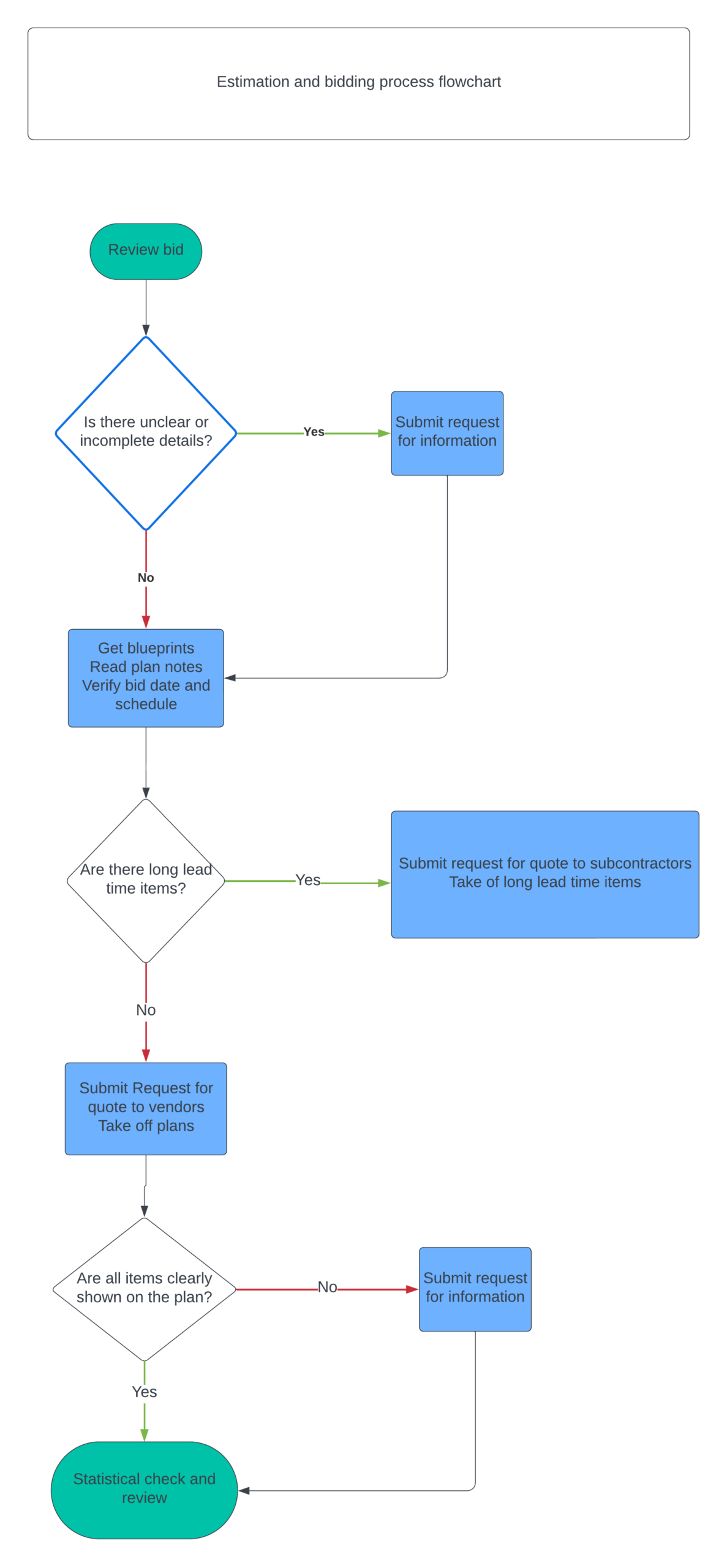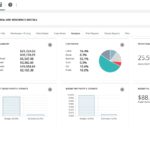Discover how a disciplined, balanced, and methodical approach can lead to accurate pricing and increased sales. Learn from a decade of experience and understand why cutting corners can be costly.
Remember, the success of your bid lies in the details – from the accuracy of your plan take-off to the competitiveness of your basics
Estimation vs bidding
Estimating should be thought of as the methodology for calculating the cost and pricing for a particular job or set of plans. Bidding, per se, is sister to the process, where the estimate is clothed with a bid document, adorned with value-added information for the client, and finally presented in a manner conducive to a sale.
Estimating and bidding are both arts and sciences. Both require thought and planning.
Remember, however, that you estimate a price. You bid to a client to receive the award of a contract. Many people casually think of the two as the same process.
However, when you stop considering the actual work and activity involved, you become aware that estimating and bidding are distinctly different and require different skills and efforts.
Estimating and bidding are not activities that can be approached casually or rushed. A disciplined, balanced, and methodical approach to both will result in the highest pricing accuracy and the highest percentage of sales.
Too much weighs in the balance at any point in the process, such as when rushing or cutting corners.
Plan take-off and estimating are particularly demanding in focus, accuracy, and the ability to insightfully and continuously ask “what ifs” about every aspect of the plan.
Bidding demands fine writing skills, a great understanding of your client’s desires and needs, and the ability to condense complex information and process into a concise and well-communicated document. Further, bidding enhances good sales and marketing skills, for without the sales side, the bid on the contract will generally fail.
You must adhere to the standard process and protocols to maintain order, accuracy, and efficiency in your bidding processes.
A decade of experience has shown that adherence to your developed protocols saves everyone from the grief of estimate errors and it enhances the likelihood of your success.
Estimating and bidding for commercial housing projects
The landscaping field covers a broad scope of job types and estimating protocols and practices.
Residential work has different estimating requirements than large parks and public works. Production front yards and slopes vary greatly from freeway work or high-rise apartments.
The typical nature of the work requirements in the narrow scope of landscaping will allow you to significantly streamline and focus on estimating processes.
This, in turn, will allow you to increase bidding accuracy while expediting the overall process.
You should standardize your cost database and procedures to allow relatively new employees to produce accurate bids for the standard scope of work. Of course, none of this replaces experience, which is increasingly required for complex and multifaceted jobs.
Your cost database should be created from your years of experience in your target market within the landscaping industry.
Unit costs that fairly and accurately reflect real material, labor, and equipment costs for a typical landscaping project should be created.
As you know, “typical” implies an average, and not all jobs are “average”. Therefore, the estimator must understand that the labor and equipment factors in the cost database must be adjusted for most jobs.
The software doesn’t know the conditions of your job site. You must apply factors, one way or the other, to compensate for actual site conditions.
This is, of course, where the experience comes in. It is not uncommon to adjust labor rates plus or minus 5% to 35%, depending on the type of job being bid. A bid is never complete until labor, equipment, material, and markup adjustments have been considered and applied to the estimate.
Always review each estimate for adjustments to bring the costing in line with real-world site conditions.
Of course, the bid is primarily won or lost based on the accuracy and competitiveness of basics:
- How accurate is the actual plan take-off?
- How accurate is the math work on the take-off quantities?
- How hard has the subcontractor price been shopped?
- How accurate is the site review assessment?
- How hard have the materials been shopped out?
- Has the labor and equipment been appropriately adjusted to the site conditions?
- Have all contingencies been accounted for?
- How well is the bid letter written, and has the bid been submitted on time?
- On particularly competitive bids, have you re-contacted the vendors and subcontractors for help in cost reductions?
All these issues are essential, yet each can easily control whether a bid is awarded to your company or lost. At no point in the cycle can the estimator lose intensity or cut corners. A classic error of cutting corners is as follows:
A valued client asks us to bid on a tremendous and attractive job. It may be a park or perhaps an elaborate model site. Your sales team may wait a little too long before starting on the bid, yet still perform an accurate landscape and irrigation take-off.
Unfortunately, they may have waited too long to submit the plans to the various hardscape contractors. By the bid due date, instead of having two or three solid bids for each subcontractor trade, they have one or two each. Perhaps they only have one bid for essential items like pools and tennis courts.
The hardscape may account for half or more of the final bid amount on a bid such as this. Unfortunately, by failing to properly bid out the hardscape items to multiple subcontractors in advance, your team is left with matching their thoughtful irrigation and landscape estimate to very few choices of hardscape bids.
In effect, you have taken one-half of your bid and presented it to the client without careful shopping for the best value price. You have unwisely “hitched your wagon to the horse of your subcontractors.”
If perhaps, you have lucked out and received the most competitive pool or tennis court bids, then you are fortunate, and the clients recognize the value in your bid.
On the other hand, (and most likely) if your lone subcontractor(s) were, in fact, higher-priced, your clients will immediately see the disparity when comparing your bid to those of your competitors.
In such a case, you were doomed from the start and wasted significant time and money. Your bid will only create a notion with your client that your landscaping company is a high-priced contractor, and that you do not provide a good value.
A simple mistake of failing to obtain multiple subcontractor bids on the complex job on a complex job will doom and waste all of your hard estimation work on the balance of the bid.
No corners can ever be cut. Doing so simply wastes the overall effort and risks alienating your clients.
A sister estimating error to that illustrated above is failing to refer your larger estimates to Purchasing before finalizing the bid. Very often, vendors will give substantial price breaks for large-scale projects.
In such cases, the material process reflected in your cost database will not accurately reflect the available street pricing for material processes for those larger jobs.
In short, you must always follow the Estimation and Bid Process outline. Deviance from these practices risks making all your efforts and hard work a literal waste of your time and your company’s money.
Estimation and Bidding Process
Just like projects’ life cycles, estimates at your company should follow a predictable and routine cycle. It is important to remember that the process represents the critical path to completing estimates promptly while gathering all necessary information.

Step 1: Review the scope of work
Upon receipt of plans, perform a cursory review of the scope of work.
The first step is to quickly review the plan for those items requiring long lead times for costing.
Subcontract work, specialty fixtures, and materials for large jobs need to be sent out for pricing at the beginning of the estimating process.
After it is done, the estimator is free to begin quantifying what is on the plan (take-off).
Use the initial review of the pans to identify items requiring lead time. Then, put them out for pricing way in advance of the bid due date so that you will have all necessary information at hand when the time comes to compile the bid.
Make sure that you get at least two, if not three, bids for all important subcontracted and specialty items. Failure to procure multiple quotes for important subcontractors and specialty items is tantamount to intentionally and negligently wasting your limited time and valuable company funds.
As estimators, we often feel very busy and overwhelmed with many activities. We are working on multiple other estimates, calling vendors and subcontractors, participating in important meetings.
Meanwhile, it may seem our clients are burying us with bid requests. Sometimes we feel like we need to “hurry up and get the bid out.” We feel pressured to clear our desks, schedules, and “get a number back to the clients.” This response to pressure is a terrible trap that routinely catches too many of us.
Estimation and bidding are a sharp, double-edged sword. A fine and accurate bid wins your client’s appreciation and business. A haphazard, inaccurate, or late bid not only loses the immediate job but also creates negative impressions of your company in your client’s mind.
Each bid is a chance to win work and build respect and reputation. However, each bid also has the potential to disappoint your client and damage our hard-earned reputation. Everything you do has long-term repercussions, for better or worse.
Therefore, when you commit to performing a bid, you must always undertake the entire process with a complete commitment to provide the most accurate, high-value bid.
Because a large portion of your estimate pricing might be contained in subcontractor work or specialty items, failing to properly obtain multiple competitive bids from your suppliers does your client a terrible disservice.
Step 2: Visit the site for an accurate assessment
Sales must visit the job site before entering the take-off information into the estimate.
It is often helpful to take photos of the job site conditions for use in the bid review process back at the office.
You want to obtain accurate information regarding the site’s condition, soil characteristics, equipment access, water and power availability, and conflicts with other trades to assess labor costs for your estimate as accurately as possible.
Do not estimate important jobs Blind: “If the job is worth your time to bid, it is worth your time to perform a field survey visit.”
All site condition realities should be reflected in your estimate pricing.
Remember that labor, overhead, and material pricing can be calculated before visiting the site, but your software might only show an average number.
The software does not know the soil’s hardness or other site conditions.
A proper site visit provides insight, enabling you to adjust the computer pricing to the demands of each job site.
In the end, often, the root cause of a “loser” job is found right at the start of the estimate: the lack of a thorough site inspection. Make sure you get the facts on the site and reflect these facts in your estimate costing.
Step 3: Perform take-off and discovery
Perform a plan take-off.
Before you begin the take-off, ensure you correctly understand the client’s requested phasing for bid partitioning or break out.
Think through the estimate divisions before you even start the take-off work.
- Does the client have their bid document?
- How does the client want the various physical areas of the project divided for pricing?
- How shall the various aspects of work be divided, i.e.: landscape, hardscape, and irrigation?
- What is the timing of each phase? Are there possible material price increases for the later phases?
Such concerns must be reflected in how you construct your zones, which will become sections of the bid.
A section is no more than a logical division of costs, based either on each type of work, the timing of the various phases, or your client’s desired cost breakdown.
You must set up these sections on the computer, but most importantly, you must also perform your take-off according to the required sections or phases.
Unfortunately, it is too frequently that an Estimator finds that he or she must completely rezone a plan because the original take-off was performed without the proper phase divisions.
Before beginning the take-off work, always understand your client’s desired bid breakdown and phasing.
Be sure to double-check all your calculations and have a paper trail for all your take-off and math work. Your take–off work and math calculations must be easily checked and confirmed by a third person during the bid review process.
So, keep things well organized and verifiable. If you use a digitizer, spot-check the take-offs to ensure the machine operates correctly and is accurately calibrated.
Vendors will generally offer considerably cheaper material pricing for larger-scale projects. Prices drop even for typical materials like pipes and heads when the jobs are large.
Therefore, when estimating larger jobs, get a material list to your purchase department well in advance so they can shop the materials while you perform the take-off work.
This way, your bid to the client can take advantage of potentially advantageous “street pricing” for your large project.
While performing the take-off, remember that you are not only quantifying the material and work depicted on the plans. You are also performing discovery for your bid document’s Important Job Concerns, Value Engineering Options, and Bid Qualifications sections.
Keep a legal pad to the side of your plans and make running notes of any plan or job issues that relate to the concerns.
As you work through the plans, continue to ask yourself what may concern the design. How can the value be enhanced? Where are the pitfalls or problems for the client? Take the time to write down all your concerns and ideas.
When it comes time to write the bid letter, your thoughtful notes will become a treasure trove of ideas for your commentary on your clients.
Step 4: Create a bid letter
Take time to complete the bid letter thoughtfully.
Your clients would truly appreciate the important job concerns and your suggestions, which rank second in importance to the actual bid price.
You should write the essential job concerns section in a dialogue format. Do not use bullets. Thoughtfully explain to the client any issues that may or could unusually impact the client’s interest—for either good or bad.
Plant suitability for the region, irrigation specification or design, hardscape suitability or cost, scheduling concerns, conflicts with local codes, fixture selections, timing… anything.
Put yourself in your client’s shoes, and inform the client what he needs to know to make a truly informed and beneficial bidding decision.
A complete and thoughtful section on Important job concerns in your bid letter can differentiate your impressive bid document from the average typical bid from most of your competitors. Do not skimp on your thoughtfulness and thoroughness.
Similarly, most of your clients would also appreciate thoughtful value engineering suggestions.
Do not simply use the tired suggestion of “downsizing the plants” as the basis of your analysis.
Consider the project’s actual specifications and design. What can be improved at the same cost, or what can be supplied at a lower cost?
Architects frequently over-specify their designs compared to your client’s needs or desires.
Specialized high-priced plant varieties, hardscape specifications beyond the site’s requirements, excessive controller expense, and excessive irrigation design are just some areas ripe for review.
Thoughtful suggestions plainly and intelligently explained, can win you the job over your competitors.
Step 5: Review the bid
Use this simple checklist to analyze the accuracy of your take-offs and bid entry.
While the bid review checklist does not uniformly apply to all jobs, it helps to eliminate math, take-off, and keystroke entry mistakes from your bid.
Take the time to work through the bid review checklist completely. Before moving on to the bid letter, you must validate and modify, if necessary, any factors that appear negative in the review criteria.
- Review information sheet and plans with the client
- Verify the scale against the given dimension in each plan
- Check math on takeoff twice
- Slope factors added
- Geotechnical reports and structural plans are shared with subcontractors
- Traffic control reviewed
- The estimation scope matches the proposal
- Review notes
- Significant job concerns and suggestions reviewed
- Takeoff matches the client’s understanding of the scope
Schedule a review time with a third person (your senior or your partner).
An additional person should review the bid review form, the take-off sheets, the plans, and any bid notes for accuracy and professionalism.
The purpose of the bid review is not to rely on the other person to find any items you may have missed. These mistakes should be corrected and expunged from your estimate and bid document before your third-party review.
The primary purpose of the review is to check the overall estimate and bid document for content and markup values, and perform one last double-check review for your estimate work to ensure compliance with procedures and accuracy.
During this bid review, the third party should:
- Review all sheets on your plans for pertinent notes and construction details.
- Check the Bid Review Criteria to help ascertain the estimate accuracy.
- Check your take-off sheet for math errors.
- Review your take-off for potentially missed materials or areas.
- Review the actual bid for labor, material, equipment, and subcontractor pricing accuracy.
- Discuss and adjust, if necessary, the markup and labor rates value relative to the job’s competitiveness and relevant site conditions.
- Review the bid letter for significant job concerns, suggestions, and bid expulsions content.
- Note any corrections that should be made and blessed before submission to the client.






